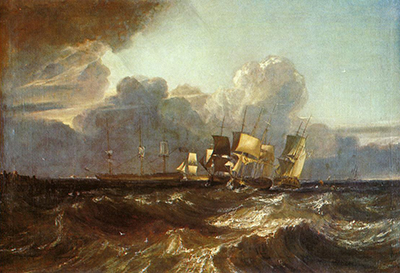This classical seascape from Turner was exhibited in 1802 and was gifted to the UK Government in the 1950s to settle some outstanding taxes owed.
The scene features a number of large ships making their way through some rough seas, which is entirely typical of the artist's work in this genre, where man and nature would often be pitted against each other. Something unusual about this composition is that no one, individual, ship takes your eye more than any other. Normally there would be a clear hierarchy of importance to help the viewer navigate the scene, but in this case we are left with a flurry of waves in the foreground and then a collection of inter-connected ships in the far. No figures are visible either, so there is a loss of the human touch in this painting. Perhaps the balance is not quite what we would expect of Turner here, and this point is better underlined by comparing Ships Bearing up for Anchorage the Egremont Sea Piece with some of his other seascapes, such as The Fighting Temeraire and Shipwreck.
Petworth House has displayed this painting for many years but in the 1950s it was handed over to the Government as payment for a number of outstanding debts. It was a part of the contents of the State Rooms, all of which was taken at the time. It was then allocated to the Tate Gallery in the 1980s but remains in its original location at the time of writing. The nation has acquired a number of famous paintings in this way and it has helped to keep as much art in the country as possible, with more and more foreign collectors seeking to pick at what is an impressive collection of European art from the past five centuries that lies under the ownership of the United Kingdom nation. Most of Turner's own paintings were bequethed to the state on his death and this has allowed his best work to be viewable, normally for free, by anyone and everyone for many decades.
Further information around the history of the piece has been discovered in the past records of Petworth House, which has held an annual inventory every year since this painting first made its way into their collection. It is easy to understand how a large stately building could fall behind on its bills and be forced to use some of its assets to pay these off, though eventually this technique will lead to nothing else left to sell, other than land and the property itself.




